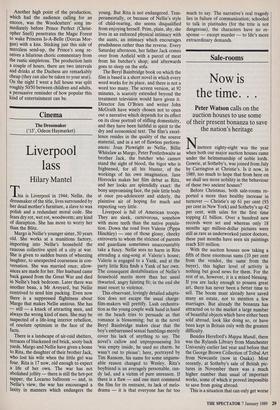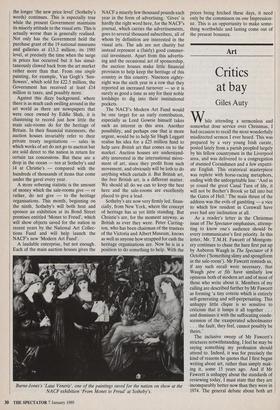Sale-rooms
Now is the time. . .
Peter Watson calls on the auction houses to use some of their present bonanza to save the nation's heritage Nineteen eighty-eight was the year when both our major auction houses came under the helmsmanship of noble lords. Gowrie, at Sotheby's, was joined from July by Carrington at Christie's. Is it now, in 1989, too much to hope that from here on we shall see more nobility in the behaviour of these two ancient houses?
Before Christmas, both sale-rooms re- ported a more than healthy increase in turnover — Christie's up 61 per cent (93 per cent in New York) and Sotheby's up 42 per cent, with sales for the first time topping il. billion. Over a hundred new records were set and whereas only 18 months ago million-dollar pictures were still as rare as underworked junior doctors, these past months have seen six paintings reach $10 million.
With the auction houses now taking a fifth of these enormous sums (10 per cent from the vendor, the same from the buyer), this higher level of activity is nothing but good news for them. For the rest of us, however, it is a mixed blessing. If you are lucky enough to possess great art, there has never been a better time to sell. The boom must already have saved many an estate, not to mention a few marriages. But already the bonanza has attracted on to the market a large number of beautiful objects which have either been sold abroad, look like doing so, or have been kept in Britain only with the greatest difficulty.
Besides Hereford's Mappa Mundi, there was the Rylands Library from Manchester University earlier last year and before that the George Brown Collection of Tribal Art from Newcastle (now in Osaka). Most recently, at Sotheby's sale of British pic- tures in November there was a much higher number than usual of important works, some of which it proved impossible to save from going abroad.
This is a situation that can only get worse the longer 'the new price level' (Sotheby's words) continues. This is especially true while the present Government maintains its miserly attitude to the visual arts. This is actually worse than is generally realised. Not only has the Government held the purchase grant of the 19 national museums and galleries at £13.2 million, its 1985 level, at precisely the time when the surge in prices has occurred but it has simul- taneously clawed back from the art market rather more than that. From one single painting, for example, Van Gogh's 'Sun- flowers', which sold for £22.5 million, the Government has received at least £14 million in taxes, and possibly more.
Against this dizzy background, where there is as much cash swilling around in the art world as there are newspapers that were once owned by Eddie Shah, it is chastening to record just how little the main sale-rooms do for the heritage of Britain. In their financial statements, the auction houses invariably refer to their private treaty negotiations — sales in which works of art do not go to auction but are sold direct to the nation in return for certain tax concessions. But these are a drop in the ocean — ten at Sotheby's and 14 at Christie's — compared with the hundreds of thousands of items that come under the gavel every year.
A more sobering statistic is the amount of money which the sale-rooms give — or rather, do not give — to the heritage organisations. This month, beginning on the ninth, Sotheby's will both host and sponsor an exhibition at its Bond Street premises entitled `Monet to Freud', which will show objects saved for the nation in recent years by the National Art Collec- tions Fund and will help launch the NACF's new 'Modern Art Fund'.
A laudable enterprise, but not enough. Each of the main auction houses gives the NACF a miserly few thousand pounds each year in the form of advertising. 'Gives' is hardly the right word here, for the NACF's journal, which carries the advertisements, goes to several thousand subscribers, all of whom by definition are interested in the visual arts. The ads are not charity but instead represent a (fairly) good commer- cial investment. Apart from this advertis- ing and the occasional act of sponsorship, the auction houses make little financial provision to help keep the heritage of this country in this country. Nineteen eighty- eight was the sixth year in a row that they reported an increased turnover — so it is surely as good a time as any for their noble lordships to dig into their institutional pockets.
The NACF's Modern Art Fund would be one target for an early contribution, especially as Lord Gowrie himself takes such an interest in this area. Another possibility, and perhaps one that is more urgent, would he to help Sir Hugh Leggatt realise his idea for a £25 million fund to help save British art that comes on to the market. Auction houses are understand- ably interested in the international move- ment of art, since they profit from such movement, and obviously will be loth to do anything which curtails it. But British art, the best British art, is a different matter. We should all do we can to keep the best here and the sale-rooms are excellently placed to give a lead.
Sotheby's are now very firmly led, finan- cially, from New York, where the concept of heritage has as yet little standing. But Christie's are, for the moment anyway, as British as ever they were. Peter Caning- ton, who has been chairman of the trustees of the Victoria and Albert Museum, knows as well as anyone how strapped for cash the heritage organisations are. Now he is in a position to do something to help. With the Burne-Jones's 'Law Veneris', one of the paintings saved for the nation on show at the NACF exhibition 'From Monet to Freud' at Sotheby's. prices being fetched these days, it need only be the commisson on one Impression- ist. This is an opportunity to make some- thing worthwhile and lasting come out of the present bonanza.











































 Previous page
Previous page